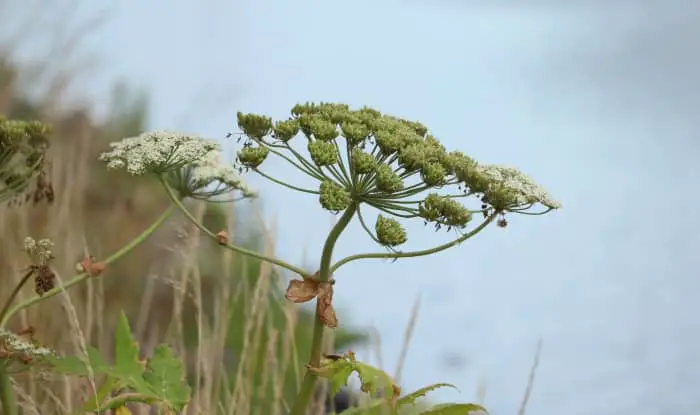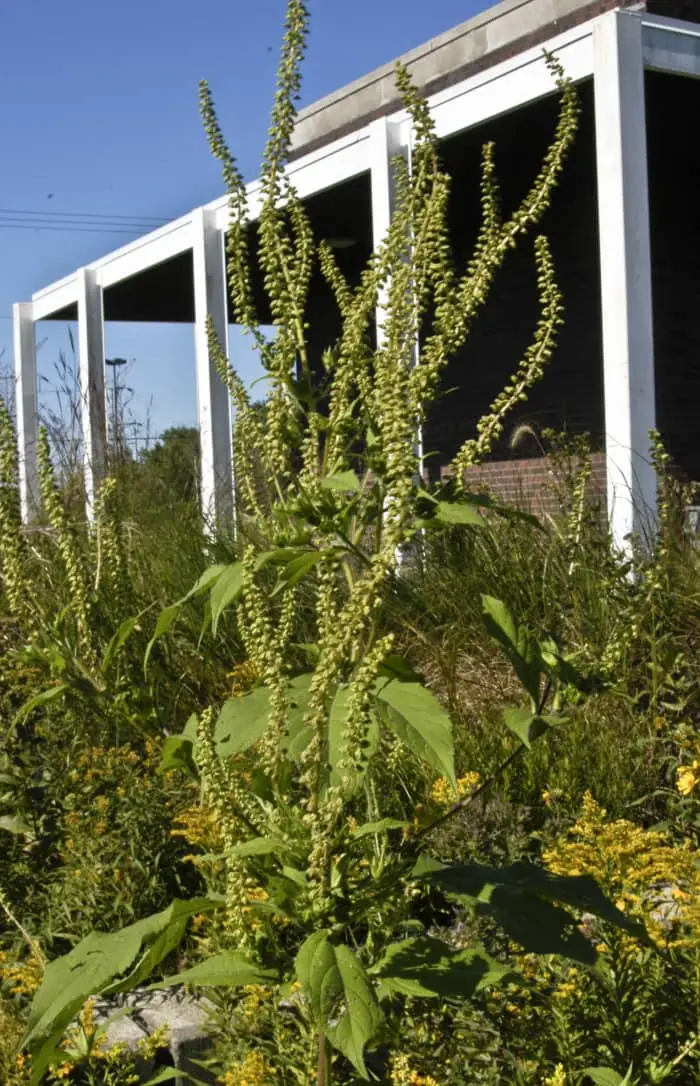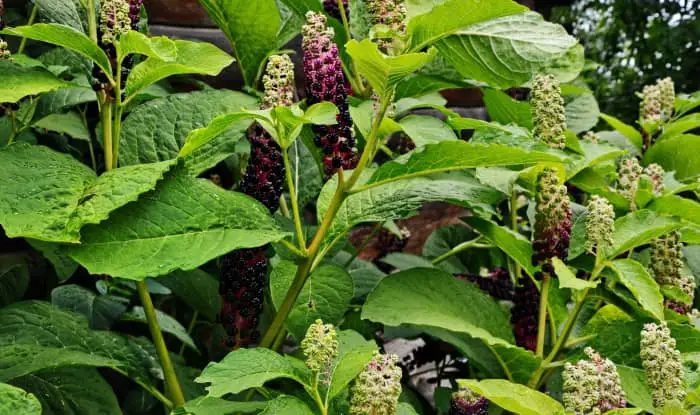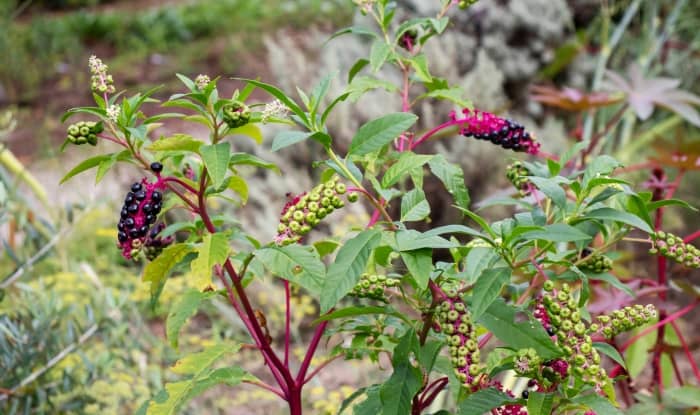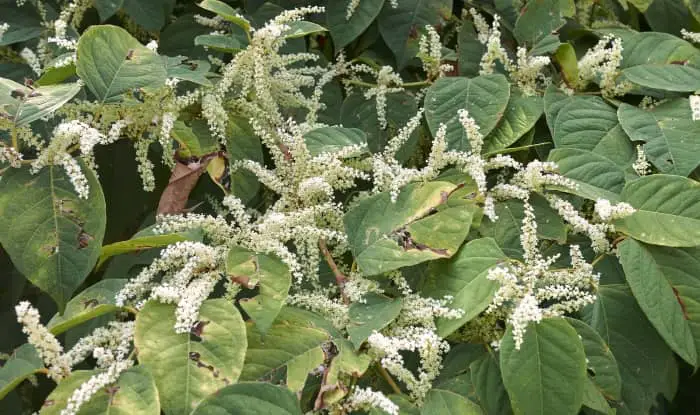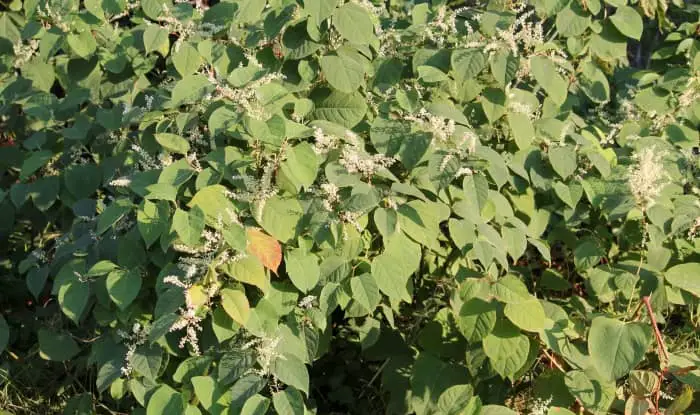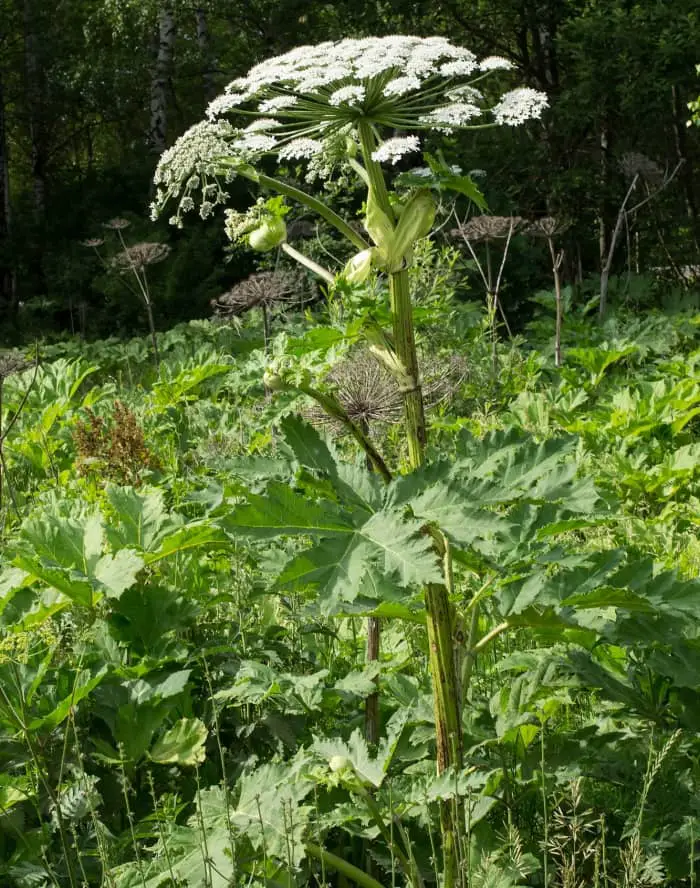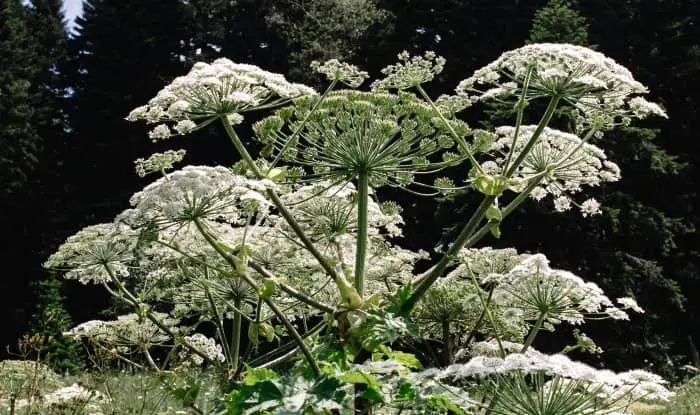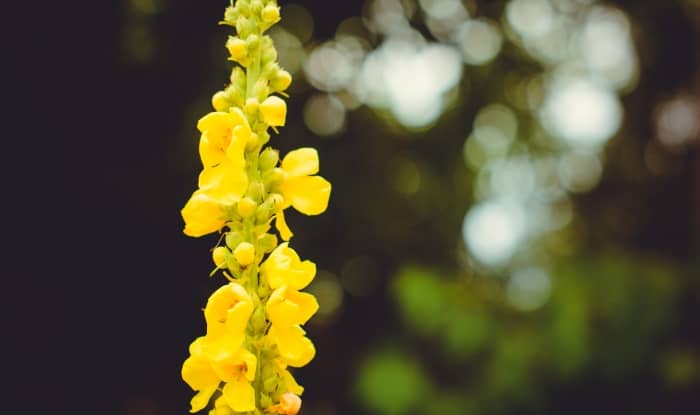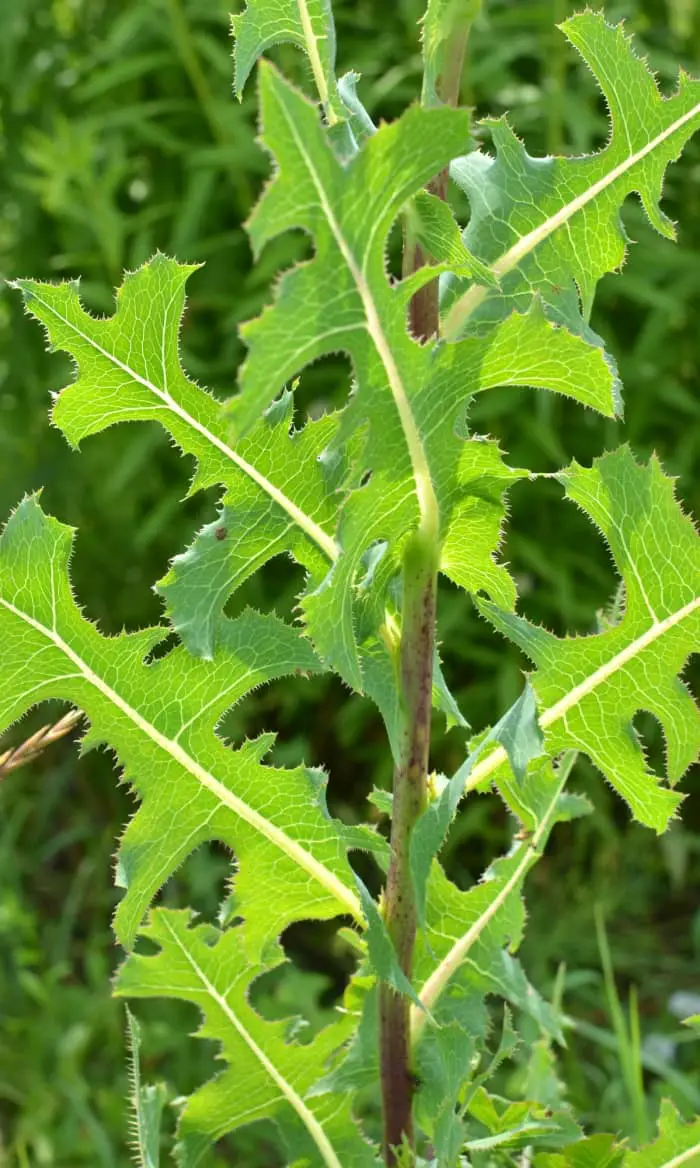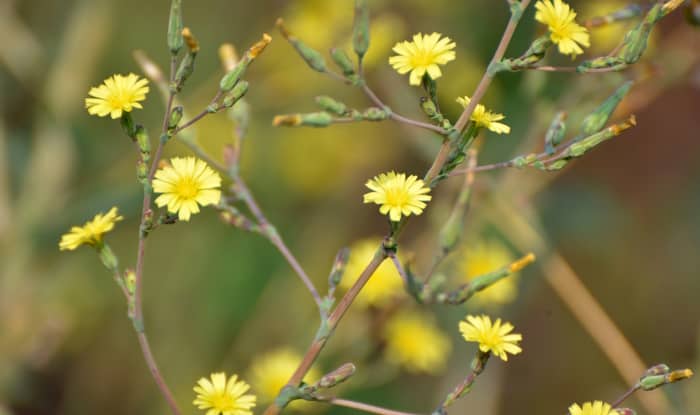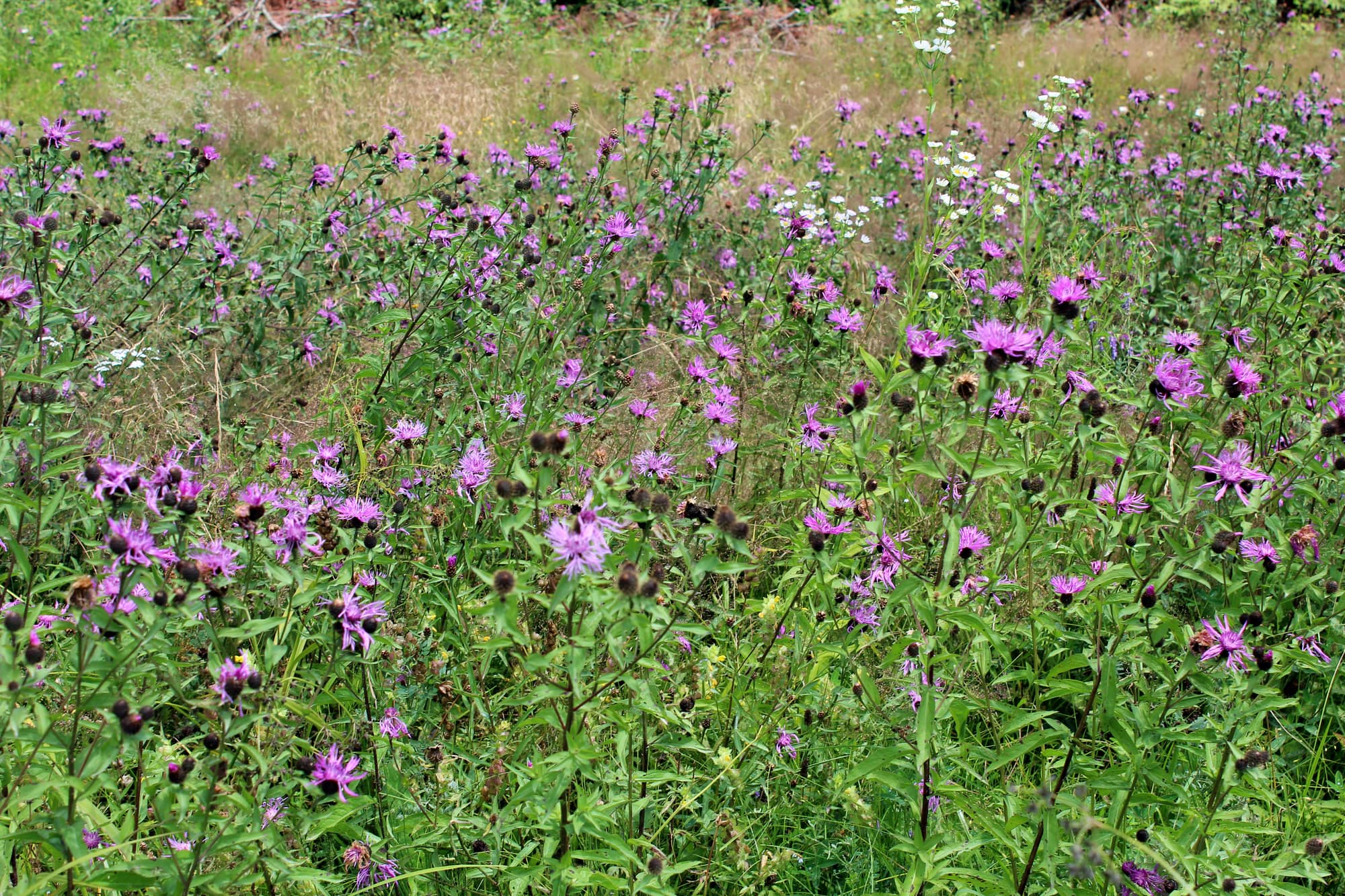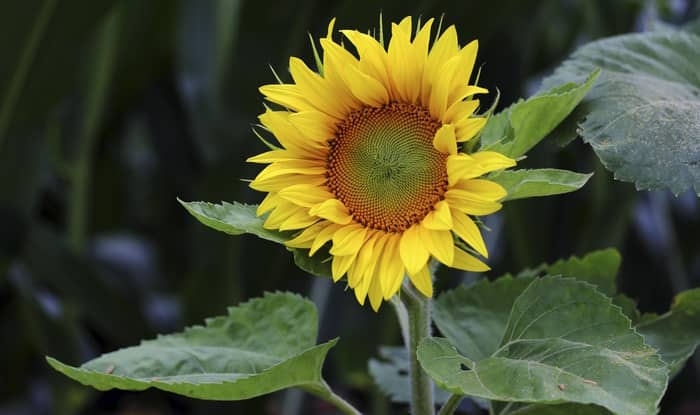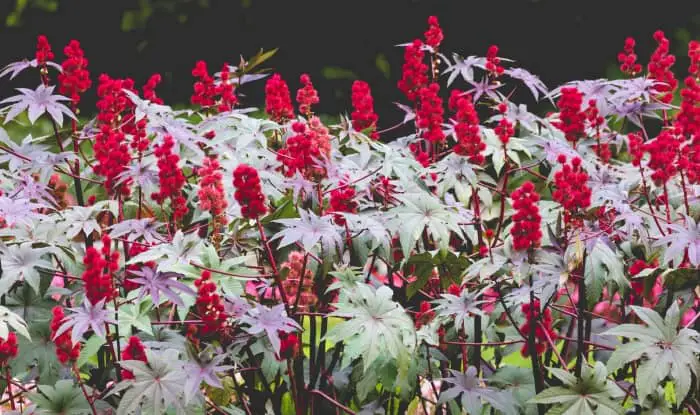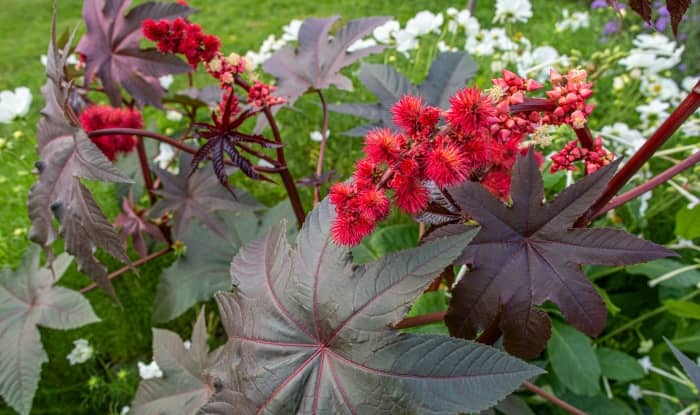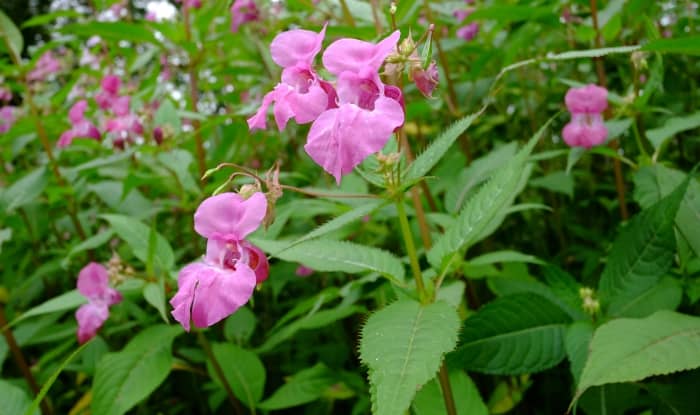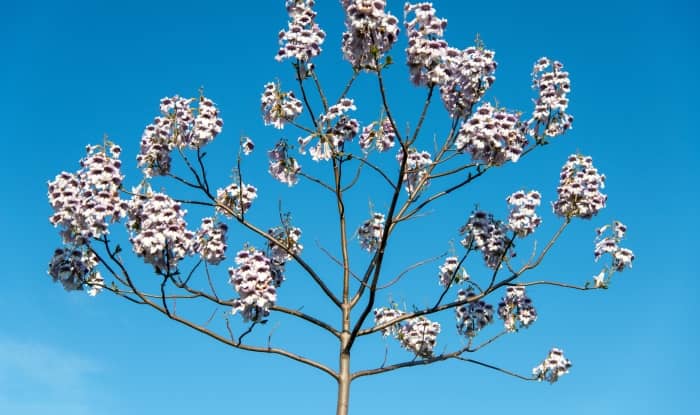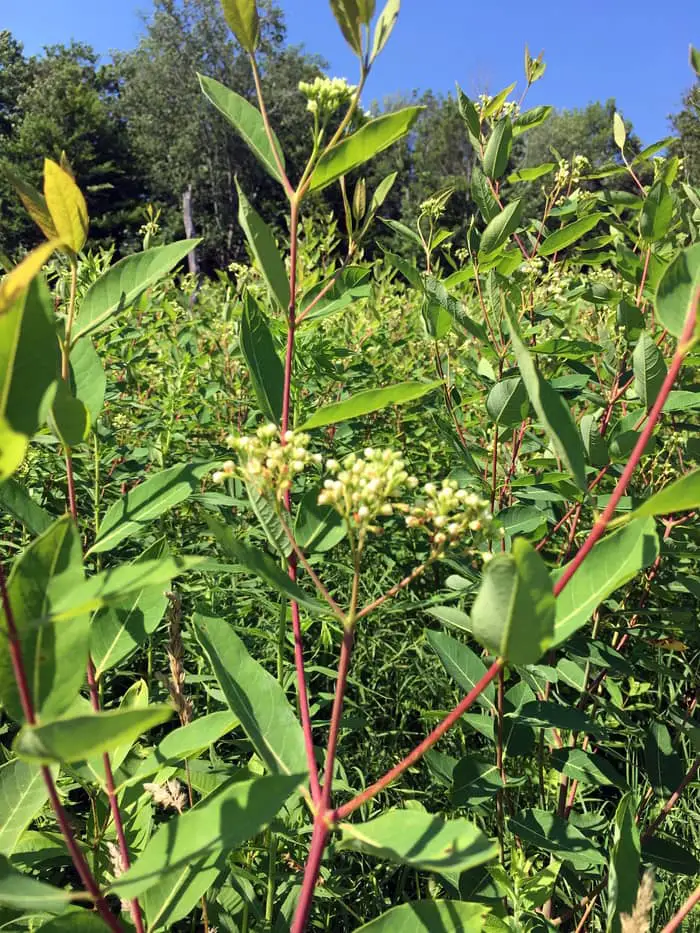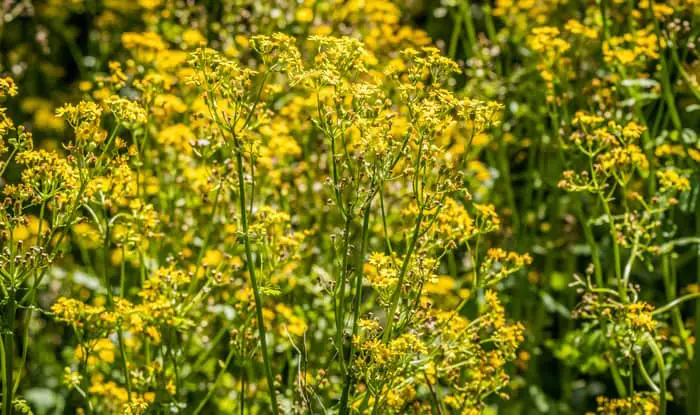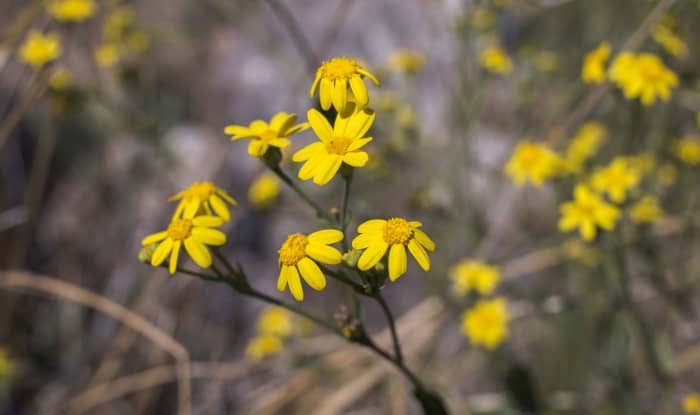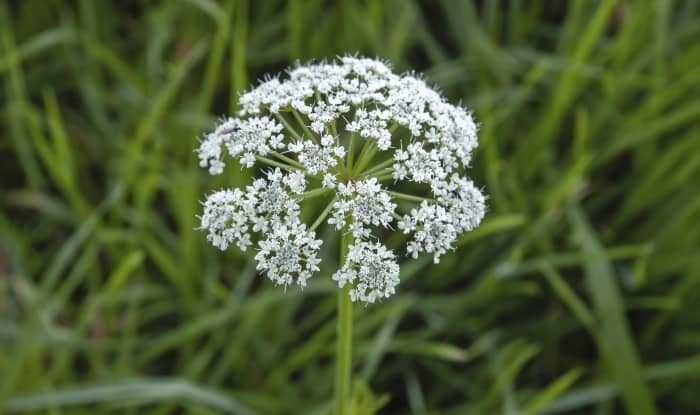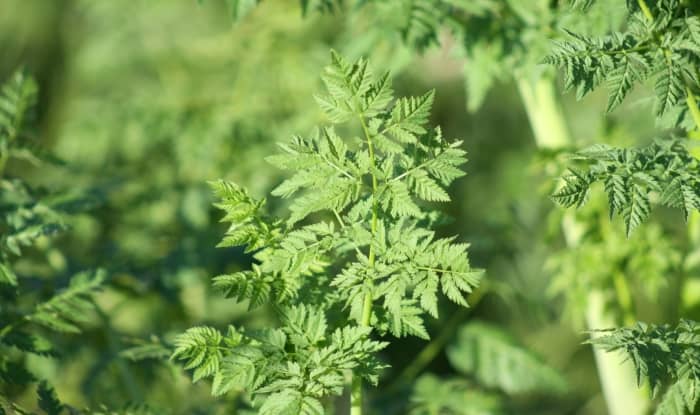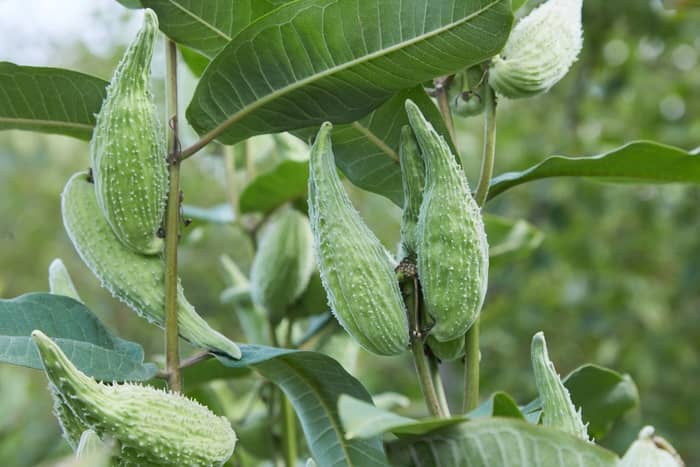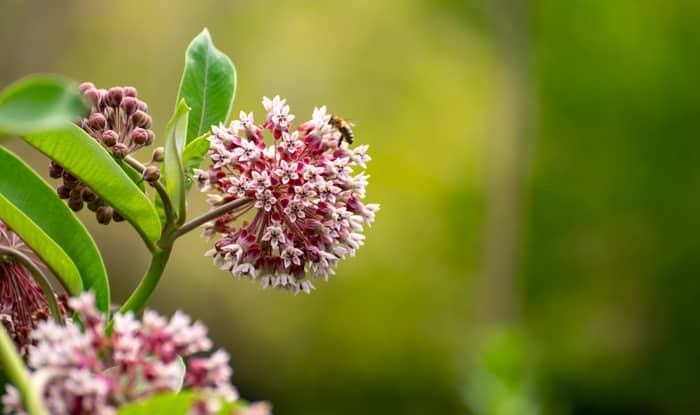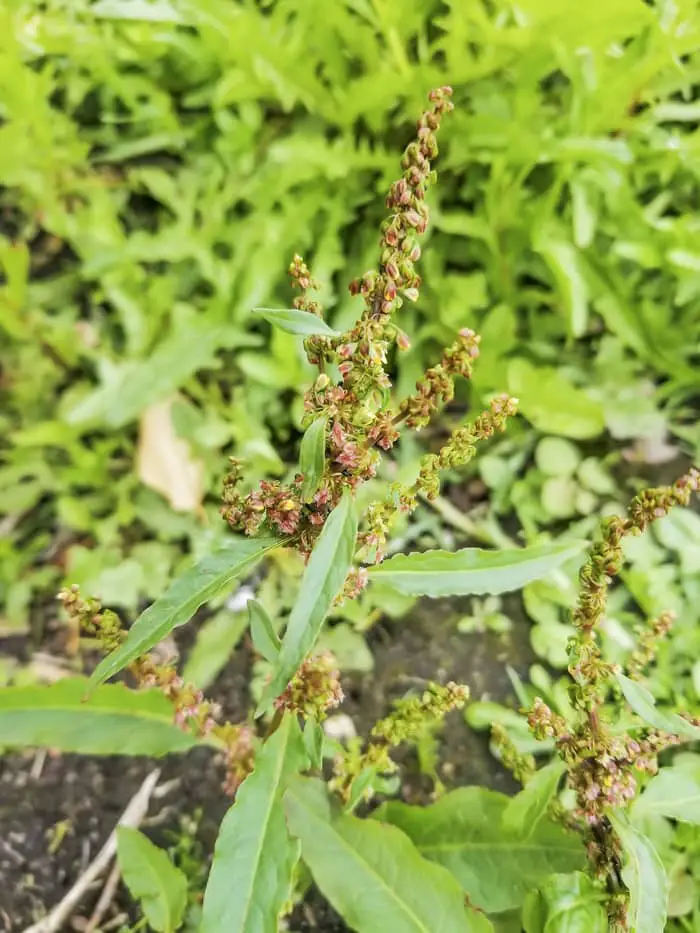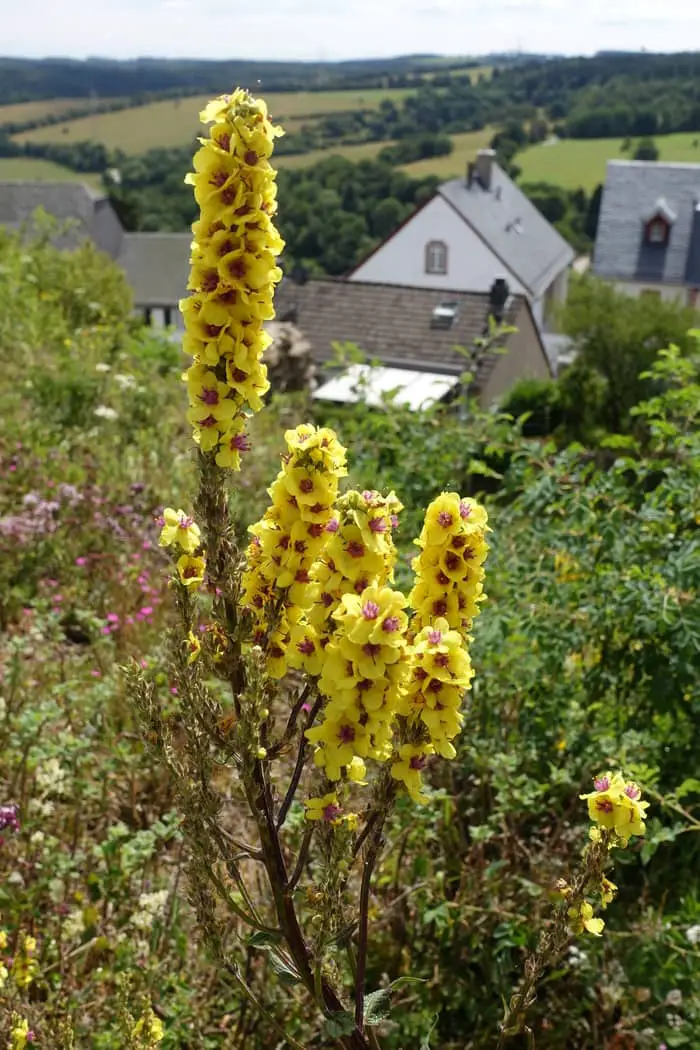When you find tall weeds with thick stalks on your land it’s important to identify them.
Some weed species are invasive and spread quickly, crowding out other plants.
If left unchecked, they can take over your yard. And they’re very hard to get rid of.
Once identified, you can plan an effective method of control.
So in this article, we take a look at 11 of the most common types and how to recognize them.
Giant Ragweed (Ambrosia trifida)
Ambrosia trifida by Frank Mayfield
This annual weed is a North American native that’s found in many parts of the US, Canada, and Northern Mexico. You can also come across it in Europe and Asia where it’s an introduced species.
It’s widely considered to be a noxious weed. And it’s destructive to other plants in the areas it invades as it outcompetes them for sunlight and puts them in the shade.
Identification:
This is a tall plant that grows between 3-12’ tall with occasional branching. The thick green stem has a coating of fine white hairs. And the large leaves have 3-5 lobes and grow up to 12 inches across.
The upper stems end in a spike of small yellowish-green flowers arranged in drooping clusters around the spike.
Seed dispersal occurs through spiky burs that people, animals, and water, carry to new locations.
Giant ragweed produces a large amount of fine pollen that’s spread easily by the wind. It’s a significant allergen that affects hay fever sufferers.
Pokeweed (Phytolacca Americana)
You might hear American pokeweed referred to by a variety of names, including phytolacca Americana, common pokeweed, poke sallet, and dragon berries.
It’s a perennial weed that’s native to the Gulf Coast, the Midwest, and the eastern US. And it’s naturalized in some parts of Asia and Europe.
The plant grows tall, usually between 4-10 feet. And produces deep reddish-purple berries that are poisonous to people, pets, and farm animals. But birds like to eat them and are responsible for spreading the seeds.
You can easily identify the plant by its berries. But if it’s not carrying fruit, then look for its thick green-purple stems, green leaves with long petioles, and green-white flowers.
It’s usually thought of as an invasive weed. It forms dense bushes and spreads rapidly. Taking over and affecting the growth of other plants.
Some horticulturalists plant pokeweed as an ornamental. But if you have children, you need to be particularly careful about growing this weed in your garden. The berries may look very attractive, but they can be fatal if you eat them.
Japanese Knotweed (Reynoutria japonica)
As the name suggests, this large perennial plant is native to Japan, as well as other East Asian countries such as Korea, China, and Taiwan.
It was introduced to Europe and the US in the 19th century. And became popular as an ornamental plant because of its bamboo-like appearance and ease of growth.
Japanese knotweed is difficult to identify when young due to the similarity of its stems and leaves with other plants. But it’s easier when it’s mature. The thick stems are hollow and you’ll clearly see the raised nodes. The stems grow tall, and the plant can reach up to 10 ft. when fully grown.
Growing out from the nodes are green shovel-shaped leaves with pointed tips. The plant comes into bloom in late summer/early fall and produces small creamy white flowers.
Japanese knotweed is an invasive plant that spreads rapidly through rhizomes once established. Many US states consider it a noxious weed because it crowds out and displaces native plants.
Giant Hogweed (Heracleum mantegazzianum)
Giant hogweed is a perennial flowering shrub that originated in the western Caucasus region of Eurasia but has now spread around the world, first as an imported ornamental plant and now as a noxious weed.
In the right conditions, the plant can grow 18 ft. tall. With a stiff tall stalk that grows up to 10 cm thick and 14 ft. high (1). When it blooms, you can see multiple clusters of white flowers growing from short stalks up into the air. They grow out from a central point, resembling an umbrella.
A fully grown plant has gigantic, deeply lobed leaves that can grow up to 5 ft. wide.
It’s sometimes mistaken for look-alike weeds such as cow parsnip, woodland angelica, purplestem angelica, lovage, valerian, and Queen Anne’s lace.
But giant hogweed grows much taller than any of these. And the stalk has reddish-purple spots and coarse bristles. None of the look-alikes have both of these.
You should wash your hands immediately if you touch hogweed. The watery sap is phototoxic and can cause serious burns if you expose your skin to sunlight.
Common Mullein (Verbascum thapsus)
Common mullein is a biennial plant that’s indigenous to North Africa, Asia, and Europe. It’s also been introduced to Australia and the US.
In the first year of growth, it develops a rosette of leaves 1-2 feet across. And then in the second year, the flowering stem grows, sometimes reaching over 7 ft. in height.
Other distinguishing features include a hairy stem. And large velvety leaves that can grow to 15 inches long and 5 inches across. The leaves are oval and covered with short hair.
A highly visible spike at the top of the stem is densely packed with 5 petalled yellow flowers.
Common mullein spreads by seed. Forming a dense ground cover that displaces native plants and wildlife.
It’s considered to be invasive in some US states.
Wild Lettuce (Lactuca serriola, Lactuca virosa)
There are many different types of wild lettuce. But the two you’re most likely to come across are Lactuca serriola and Lactuca virosa.
The plant is a biennial or annual herb. It’s also considered to be a weed.
Originally a native of North Africa, Europe, and Asia, it has spread to many parts of the world.
When it’s young, wild lettuce is sometimes confused with a common weed type: the dandelion plant. It’s a member of the same family and has a similar rosette.
But when it’s fully mature, you can find it growing 7-8 feet high in suitable conditions. The thick, strong stem sometimes has a covering of slender prickly spines. And the stem color varies in species between green, brownish-red, and purple.
The green leaves are long with deep notches and spines along the central vein on the underside.
Wild lettuce usually blooms from July to September, developing small pale-yellow flowers that resemble dandelion flowers.
The weed produces a milky sap that some people use for its sedative and analgesic properties.
Creeping Thistle (Cirsium arvense)
Creeping thistle gets its name from its creeping lateral root growth that allows it to quickly spread and form dense clumps
It’s an upright herbaceous perennial weed that’s native to Europe, North Africa, and Western Asia. But it’s now found widely around the world in suitable climates.
It was introduced to the US in the 17th century. But 43 states now consider it a noxious weed.
The plant grows up to 5 ft. high. And as its root system expands, it sends up vertical shoots and forms vast clonal colonies.
The thick green stalks are smooth and branched. And the dark green leaves are lobed and covered in sharp spines. The leaves can grow 20 cm long and 3 cm wide and are larger lower down the plant than on the upper part.
The distinctive flowers are pink-purple and consist of numerous small petals.
Its aggressive root growth, along with prolific seed production and dispersal, make this a very difficult weed to control.
Common Sunflower (Helianthus annuus)
This large annual herbaceous plant is well known for its flowers and seed production.
But would you recognize it without the impressive flower head?
If not, you can also identify it by its long, thick stem, that grows upright and is coated with fine hairs. As well as the large, green, heart-shaped leaves.
Sunflowers are part of the genus Helianthus which contains about 70 plant species that come in varying sizes and flower appearances.
Birds spread the seeds, so you might sometimes find one growing unexpectedly in your garden. And some people like to plant them as ornamentals in landscaping.
Ricinus (Ricinus communis)
A native of Asia and Africa, ricinus is now grown worldwide as an ornamental plant.
Also called castor oil or castor bean plant, it’s a fast-growing perennial shrub. And when mature, it can grow about 12 ft. tall in the right climate.
As well as its attractive appearance and commercial uses, it’s also well known for containing the deadly poison ricin. You can find this in all parts of the plant, but especially in the seeds.
It’s easy to identify ricinus:
The weed has a purple-red thick stalk and big leaves with between 5-11 fingers (2). The leaves are glossy, and change in color from dark red-purple on a young plant, to dark green as the plant grows and matures.
The fruits are also distinctive. They have a spiny capsule that’s either red or green in color. Each capsule contains large, bean-like — and highly dangerous — seeds.
Himalayan Balsam (Impatiens glandulifera)
Himalayan balsam is an annual herb that’s also known as copper tops, policeman’s helmet, gnome’s hatstand, Indian jewelweed, and touch-me-not.
As the name suggests, it’s native to the Himalayan mountain range. And more precisely, to the area between Uttarakhand and Kashmir.
It was introduced in the 19th century to Europe and North America as an ornamental plant. But it’s now often considered an invasive plant.
It grows in a range of soil types. But you’re most likely to find it along the banks of rivers and streams. You can also come across it in wetlands, forests, and roadsides. Sometimes, you might even find it growing in your lawn grass.
Identification:
Himalayan balsam grows up to 6-7 ft. tall. The red-purple stems are smooth and hollow. And they thicken as the plant grows to maturity. There are 5-10 pink or white flowers on each stem, with each flower having 5 petals. Each leaf is large, oval, and pointed at the tip.
The ripe seed capsules are fragile and explode when touched, spreading seeds for several meters. This has earned the plant the alternative name of touch-me-not.
It spreads quickly in areas it infests. Densely covering an area and crowding out the indigenous vegetation. This reduces biodiversity in the area.
Paulownia Tree (Paulownia tomentosa)
The Paulownia tree is a native of China. But it’s now found in many parts of the world as it’s often used as a decorative plant in landscaping.
It’s particularly fast-growing, expanding up to 5 meters in a year. And in some parts of the US, it’s thought of as an invasive plant
If you find this weed tree growing unexpectedly in your yard you can identify it by its large flat green leaves and tall, thick stalk.
The mature tree grows up to 25 meters tall. And it’s impressive when in bloom, with its pink-purple flowers and vanilla fragrance. But when it’s a sapling, it’s easy to mistake it for a large weed.
The weed has large, velvety leaves that fall to the ground after the first frost in the fall.
Other names for the tree include the empress tree, princess tree, and foxglove tree.
Indian Hemp (Apocynum cannabinum)
Also called dogbane, Indian hemp is a tall growing weed with a thick, central stem that branches toward the top. The stems are reddish-brown and contain a toxic, milky sap.
Indian hemp grows between 2-5 feet tall, sometimes reaching 6 feet in the right conditions. Narrow green leaves with smooth edges and a slightly glossy surface grow from the stems in opposite pairs up to 6 inches long and 0.5 inches wide.
From June to August, the plant blooms, developing clusters of tiny greenish-white flowers at the top of the stems. Following the flowers are seed pods that split to release flat, oval-shaped seeds with hairs that enable wind dispersal.
Indian hemp weed has a deep taproot that can grow 6 feet deep, making manual removal challenging. Rhizomes extend underground, enabling the weed to spread and form colonies.
Butterweed (Packera glabella)
Also called cressleaf groundsel and yellowtop, butterweed is a succulent annual native to North America. The weed develops a basal rosette of leaves in the early growth stages before sending up a hollow, thick stem in the spring.
Green leaves grow alternately from the stem, reaching up to 10 inches long and growing smaller near the top of the stem.
When the plant blooms from April to June, panicles of yellow daisy-like flowers grow at the top of the stem. Each yellow flower consists of 5-15 florets with a golden yellow disk floret at the center.
You’ll often find butterweed growing in large clumps close to swamps, streams, ponds, and forests. It also grows in areas of disturbed ground, such as agricultural fields and along roadsides.
Poison Hemlock (Conium maculatum)
Also known as deadly hemlock, poison parsley, and spotted hemlock, poison hemlock is a notorious weed.
All parts of poison hemlock are poisonous and can be fatal when ingested. Even touching the plant can be dangerous as it contains toxins that cause severe skin reactions. Make sure to wear gloves when handling this weed.
Poison hemlock is biennial. In the first year, the plant is low-growing and resembles a carrot plant. In the second year, poison hemlock grows up to 12 feet tall with smooth, thick stems with reddish or purple streaks or spots. The leaves are green and fern-like, with toothed edges.
In the second year of growth, the weed develops clusters of small white flowers at the end of the stems.
A thick white taproot that grows deep can make it hard to remove the plant by hand. Make sure you remove the entire root when digging the plant up to prevent regrowth.
Common Milkweed (Asclepias syriaca)
Common milkweed is a perennial weed that usually grows between 3-5 feet tall but can reach 8 feet in the right conditions. The sturdy, thick stem grows upright and unbranched, with large oval-shaped leaves growing from the stem in opposite pairs. The leaves have a velvety texture on the underside and are smooth on the upper surface.
From June to August, the plant blooms, developing showy clusters of small, star-shaped flowers at the top of the stem that can be pink or purple-pink.
Common milkweed prefers to grow in full sun and well-drained soil. You’ll often find common milkweed in meadows, fields, woodland edges, and roadsides. The plant spreads by seeds released from mature seedpods and rhizomes that grow from a central, deep taproot.
The plant takes its name from the milky white substance in the stems that leaks out when they’re injured.
Curly Dock (Rumex crispus)
Also called yellow dock, curly dock is a common weed found in many parts of the world, including North America, Europe, and Asia. This plant is known for its long, curly leaves and tall, stout stalks that can reach heights up to 5 feet (1.5 meters) (3).
The leaves of curly dock are long and narrow, with wavy edges that give them their distinctive shape. The leaves and stalks are typically green, although they may turn reddish-brown as they mature.
Initially, the leaves grow in a basal rosette before the stalk rapidly grows in late spring.
Curly dock produces small flowers that grow in clusters on the upper stems. Initially green, the flowers turn reddish-brown as the plant matures. Seed capsules appear in late summer and fall, containing 3-sided oval to egg-shaped seeds with a sharp point at one end.
This weed is very adaptable and can grow in a wide range of environments, including meadows, fields, roadsides, and disturbed areas. The weed prefers moist soils but can also tolerate dry conditions.
The weed spreads by producing seeds dispersed by the wind. It’s best to control curly dock before it produces seeds. Curly dock has a deep, fleshy taproot, making it hard to pull the weed by hand. You may need to use a herbicide to control a large infestation.
Black Mullein (Verbascum nigrum)
Black mullein, or Verbascum nigrum, is a biennial plant native to Europe that grows in many parts of the world. It is a member of the Scrophulariaceae family that includes plants like snapdragons and foxgloves.
Black mullein has a tall, thick, upright stalk, which can grow up to 5 1/2 feet in height. The dark-green leaves of black mullein are soft and velvety due to a covering of small hair.
The leaves grow in a basal rosette during the first year of growth and then alternate on the stem during the second year, becoming smaller the further up the stalk they grow. The stem is also covered in fine hairs and can have a reddish or purplish tinge.
The flowers of black mullein grow in a tall, spike-like inflorescence that can reach up to 3 feet (1 meter) in length. The individual flowers are small, golden-yellow, and bell-shaped, with purple stamens. The plant typically blooms in mid to late summer.
Black mullein spreads by self-seeding, with the seeds dispersed by the wind. Black mullein can grow in a variety of habitats, including disturbed soils, meadows, and open woodlands. It is a hardy plant that can tolerate a range of soil types and conditions.
If left unchecked, black mullein can become invasive and crowd out native plant species. To control its spread, pull up young plants before the roots fully develop or cut back mature plants before they set seeds.
How Do You Get Rid Of Tall Weeds With Thick Stalks?
You can kill tall weeds with thick stalks by applying a post-emergent systemic weed killer.
First, cut the stalk of the weed so that you only have about 8 inches left sticking out from the ground. Make sure you collect the plant material in a bag for disposal as some weeds can reroot.
Then apply the weed killer to the stump and any remaining leaves. The weed killer will be absorbed by the plant and travel down to the roots, killing all parts of the weed from the inside.
It’s important to use a herbicide that can kill the roots because otherwise, the weed will regrow.
If you prefer to do things the natural way then you can try to pull the weed by hand. But this can be very challenging. The problem?
You often need to remove all parts of the weed to prevent it from growing back again. And some plants have very extensive root and rhizome systems.
Some weeds, such as Japanese Knotweed, can be very difficult to completely eradicate yourself. You can try using the best commercial-grade weed killer. But you may need to hire a professional service to take care of the problem if the area is overgrown.
References:
- Giant Hogweed Identification – https://www.dec.ny.gov/animals/72766.html
- Castor Bean – https://hort.extension.wisc.edu/articles/castor-bean-ricinus-communis/
- Curly Dock – https://ipm.ucanr.edu/PMG/WEEDS/curly_dock.html
